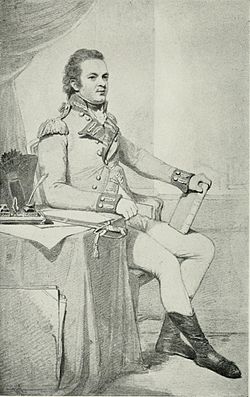John Drinkwater Bethune
| John Drinkwater Bethune | |
|---|---|
 |
|
| Born | 9 June 1762 Latchford, Warrington, England |
| Died | 16 January 1844 (aged 81) Leatherhead, Surrey, England |
| Occupation | Army officer, military historian |
| Spouse(s) | Eleanor Congalton, 22nd of Balfour |
| Notes | |
|
Arms: Party per pale, gu. and az., on a fesse, wavy, arg., three billets, of the second, between three garbs or. |
|
Arms: Party per pale, gu. and az., on a fesse, wavy, arg., three billets, of the second, between three garbs or.
Crest: Three wheat-ears, two in saltier, one in pale, or, encircled by a ducal coronet.
Motto: Labore omnia florent (trans. everything flourishes through work)
Colonel John Drinkwater Bethune (9 June 1762 – 16 January 1844), born John Drinkwater, was an English army officer and military historian, and was well known for his journal, which he kept during the Great Siege of Gibraltar.
Bethune was born at Warrington, Lancashire in 1762. The son of an ex-navy surgeon, he joined the Royal Manchester volunteers at the age of fifteen and was almost immediately posted to Gibraltar. In 1787 Drinkwater travelled to Gibraltar a second time with the second battalion of the Royal Regiment of foot. He was publicly thanked by General Eliott for his book and was given sufficient funds to establish the Gibraltar Garrison Library. He subsequently accompanied his regiment to Toulon (where he acted as military secretary during the city's English occupation) and then to Corsica (where he served as deputy-judge-advocate to the English forces stationed there).
One son, John Elliot Drinkwater Bethune was a pioneer in promoting women's education in 19th century India and in 1849 founded an institution for women's education in Calcutta. The other, Charles Ramsay Drinkwater Bethune rose to Admiral in the Royal Navy.
His last years were spent living at Thorncroft Manor, Leatherhead, a fine 18th century house. He is buried in the churchyard of St. Nicholas and St. Mary's Church, Leatherhead,
He first published his work in 1785, and a new edition of A History of the Siege of Gibraltar was published in 1905. The history of the four eventful years' siege is fully detailed also in the Memoir, attached to Green's Siege of Gibraltar (1784), of its defender George Augustus Elliot, afterwards Lord Heathfield.
...
Wikipedia
